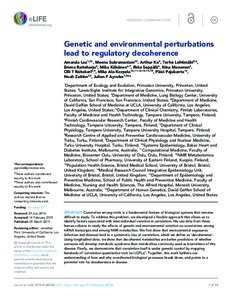Genetic and environmental perturbations lead to regulatory decoherence
Amanda Lea; Meena Subramaniam; Arthur Ko; Terho Lehtimäki; Emma Raitoharju; Mika Kähönen; Ilkka Seppälä; Nina Mononen; Olli T Raitakari; Mika Ala-Korpela; Päivi Pajukanta; Noah Zaitlen; Julien F Ayroles
Genetic and environmental perturbations lead to regulatory decoherence
Amanda Lea
Meena Subramaniam
Arthur Ko
Terho Lehtimäki
Emma Raitoharju
Mika Kähönen
Ilkka Seppälä
Nina Mononen
Olli T Raitakari
Mika Ala-Korpela
Päivi Pajukanta
Noah Zaitlen
Julien F Ayroles
ELIFE SCIENCES PUBLICATIONS LTD
Julkaisun pysyvä osoite on:
https://urn.fi/URN:NBN:fi-fe2021042826288
https://urn.fi/URN:NBN:fi-fe2021042826288
Tiivistelmä
Correlation among traits is a fundamental feature of biological systems that remains difficult to study. To address this problem, we developed a flexible approach that allows us to identify factors associated with inter-individual variation in correlation. We use data from three human cohorts to study the effects of genetic and environmental variation on correlations among mRNA transcripts and among N MR metabolites. We first show that environmental exposures (infection and disease) lead to a systematic loss of correlation, which we define as 'decoherence'. Using longitudinal data, we show that decoherent metabolites are better predictors of whether someone will develop metabolic syndrome than metabolites commonly used as biomarkers of this disease. Finally, we demonstrate that correlation itself is under genetic control by mapping hundreds of 'correlation quantitative trait loci (QTLs)'. Together, this work furthers our understanding of how and why coordinated biological processes break down, and points to a potential role for decoherence in disease.
Kokoelmat
- Rinnakkaistallenteet [27094]
